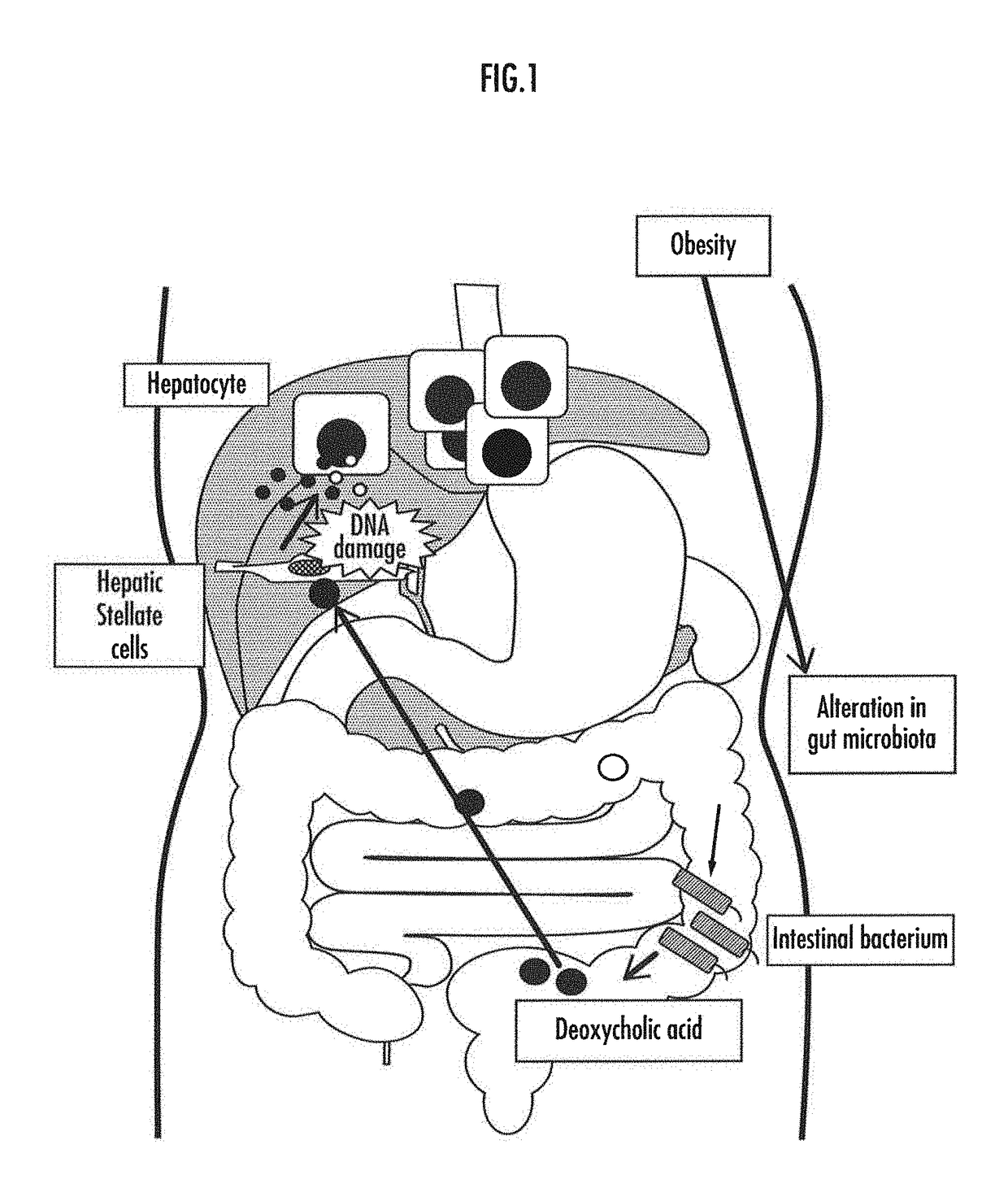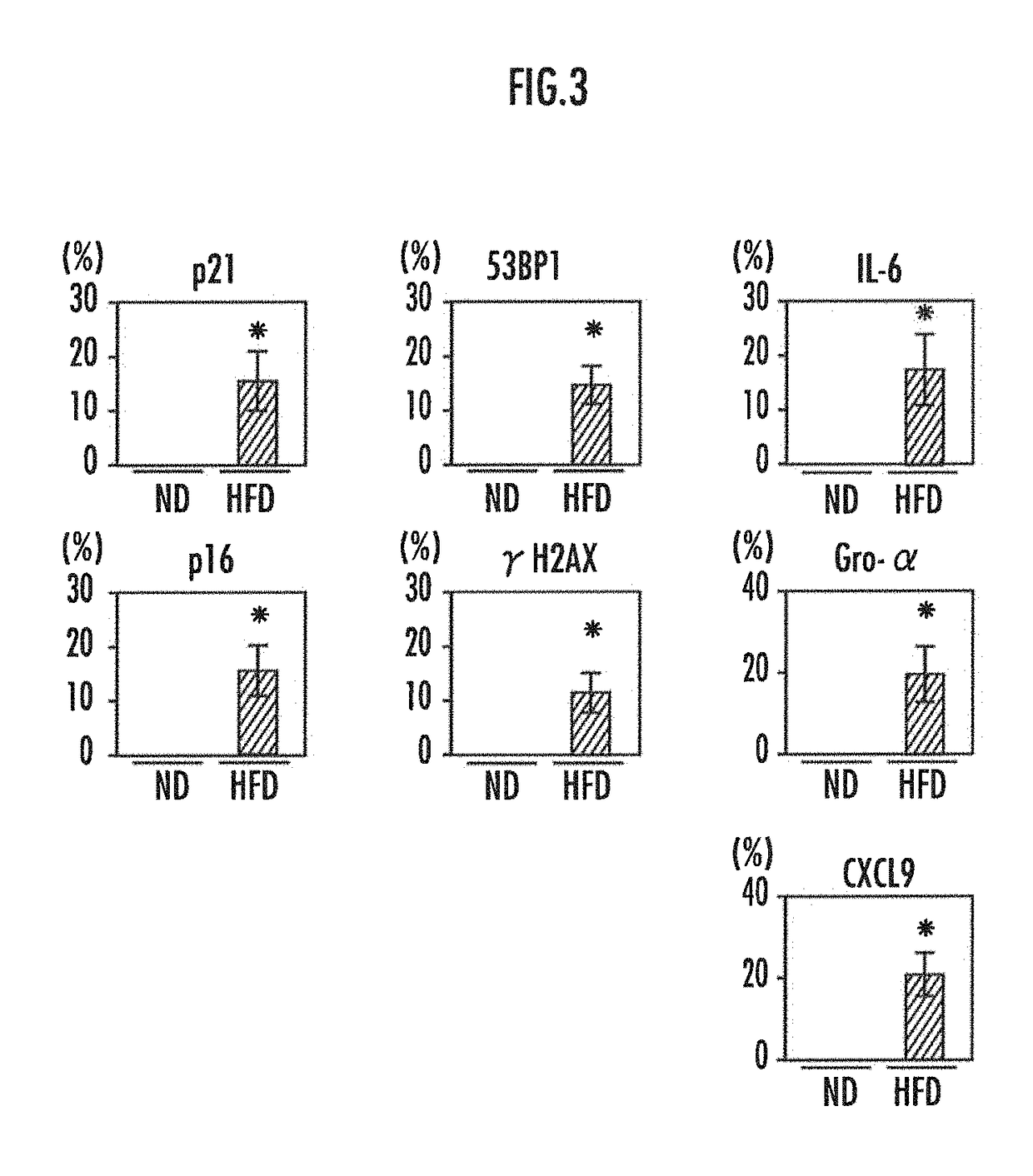Method for screening food ingredients and food compositions
a technology for food ingredients and food compositions, applied in the field of screening for food ingredients, can solve the problems of irreversible termination of cell growth, cell death called apoptosis, etc., and achieve the effect of reducing carcinogenic risk and improving gut microbiota balan
- Summary
- Abstract
- Description
- Claims
- Application Information
AI Technical Summary
Benefits of technology
Problems solved by technology
Method used
Image
Examples
example 1
on of Carcinogenesis Model with Multiple Cancer
[0097]FIG. 2A shows a method for preparing carcinogenesis models used in the present invention. An acetone solution containing 0.5% of the carcinogenic substance DMBA (7,12-dimethylbenz[a]anthracene) was applied once to the backs of wild-type (C57BL / 6) neonatal mice. The neonatal mice were raised together with their mother mouse by feeding with normal diets (ND) or high-fat diet (HFD) until 4 weeks old. The high-fat diets used were D12492 (Rodent Diet with 60% kcal % Fat; Research Diets, Inc., USA). The neonatal mice were weaned at 4 weeks old and subsequently raised with normal diets or high-fat diet. At 30 weeks old, their livers and lungs were excised, and the presence or absence of cancer development was analyzed. The average body weight of the mice at the time of dissection was 33 g for the mice fed normal diets and 51 g for the mice fed high-fat diets. The mice fed high-fat diets had approximately 1.5 times the body weights of the...
example 2
ction by Senescence of Hepatic Stellate Cell and Liver Cancer Development
[0103]Recently, it has been suggested that some secreted factors increase a risk of cancer development, and substances classified into SASP factors are included therein (Non Patent Literature 8).
[0104]Results of previous analysis revealed that cells secreting SASP factors in the liver are hepatic stellate cells. Thus, the livers of the mice fed high-fat diets and the mice fed normal diets were subjected to cell staining to analyze whether senescence occurred in their hepatic stellate cells and SASP was observed.
[0105]Double staining was carried out using the cell marker α-smooth muscle actin for hepatic stellate cells and p21 or p16 as the marker of inducing senescence, the foci of 53BP1 or γH2AX as the marker of involved in DNA damage response, IL-6, Gro-α, or CXCL9 as the principal SASP factor to analyze senescence and the ratio of hepatic stellate cells secreting SASP factors.
[0106]The results are shown in F...
example 3
nesis Inhibitory Effect by Improvement in Condition of Gut Microbiota
[0110]FIG. 4A shows the experimental schedule. DMBA was applied to wild-type neonatal mice, followed by high-fat diet feeding. From 13 weeks old, an antibiotic cocktail (4Abx, antibiotic cocktail administration group) or vancomycin (VCM, vancomycin administration group) mixed with drinking water was administered to the mice. At the 30th week after the start of the raising, their livers were excised, and liver cancer development was analyzed. On the other hand, the raising of a control group was continued in the same way as the aforementioned raising up to the 13th week. The antibiotic cocktail contained ampicillin (1 g / l), neomycin (1 g / l), metronidazole (1 g / l), and vancomycin (500 mg / l). Also, in the case of administering vancomycin alone, 500 mg / l was administered.
[0111]FIG. 4B shows the level of a gene encoding intestinal bacterial 16s rRNA of 17 weeks after antibiotic administration, i.e., 30 weeks after birth...
PUM
| Property | Measurement | Unit |
|---|---|---|
| body weight | aaaaa | aaaaa |
| body weight | aaaaa | aaaaa |
| body weight | aaaaa | aaaaa |
Abstract
Description
Claims
Application Information
 Login to View More
Login to View More - R&D
- Intellectual Property
- Life Sciences
- Materials
- Tech Scout
- Unparalleled Data Quality
- Higher Quality Content
- 60% Fewer Hallucinations
Browse by: Latest US Patents, China's latest patents, Technical Efficacy Thesaurus, Application Domain, Technology Topic, Popular Technical Reports.
© 2025 PatSnap. All rights reserved.Legal|Privacy policy|Modern Slavery Act Transparency Statement|Sitemap|About US| Contact US: help@patsnap.com



